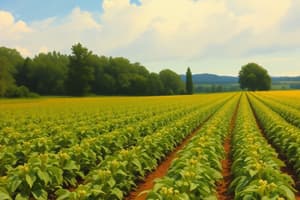Podcast
Questions and Answers
Which outcome is LEAST likely result from implementing a well-designed crop rotation strategy?
Which outcome is LEAST likely result from implementing a well-designed crop rotation strategy?
- Enhanced weed control through altered growing conditions.
- Improved soil structure, promoting better water infiltration and aeration.
- Increased reliance on synthetic fertilizers due to varied nutrient demands. (correct)
- Reduced pest and disease incidence by disrupting their life cycles.
A farmer notices a persistent issue with a specific soilborne disease affecting their tomato crop annually. How could crop rotation be strategically employed to address this problem?
A farmer notices a persistent issue with a specific soilborne disease affecting their tomato crop annually. How could crop rotation be strategically employed to address this problem?
- By increasing the density of tomato plants to overwhelm the disease.
- By planting tomatoes in the same location every year to build resistance.
- By applying a broad-spectrum pesticide to eradicate the pathogen.
- By alternating tomatoes with non-host crops to disrupt the disease cycle. (correct)
When planning a crop rotation, what is the most important consideration regarding crop selection to enhance soil health and fertility?
When planning a crop rotation, what is the most important consideration regarding crop selection to enhance soil health and fertility?
- Selecting crops with diverse root structures and nutrient uptake patterns. (correct)
- Selecting crops with similar nutrient requirements to simplify fertilization.
- Planting the same crop family in sequence to maintain soil consistency.
- Choosing crops solely based on their market value and profitability.
A farmer is considering incorporating a legume into their crop rotation. What primary benefit should they expect from the legume in terms of soil fertility?
A farmer is considering incorporating a legume into their crop rotation. What primary benefit should they expect from the legume in terms of soil fertility?
What is the most direct way that crop rotation contributes to weed control in agricultural systems?
What is the most direct way that crop rotation contributes to weed control in agricultural systems?
How does crop rotation impact soil erosion compared to monoculture farming?
How does crop rotation impact soil erosion compared to monoculture farming?
A farmer wants to improve water infiltration in their field. Which of the potential crop rotations would best support that goal?
A farmer wants to improve water infiltration in their field. Which of the potential crop rotations would best support that goal?
In regions with unpredictable rainfall patterns, how can farmers adjust their crop rotation?
In regions with unpredictable rainfall patterns, how can farmers adjust their crop rotation?
How does the inclusion of cover crops into a crop rotation strategy directly benefit soil health?
How does the inclusion of cover crops into a crop rotation strategy directly benefit soil health?
What is a primary challenge associated with implementing diversified crop rotations compared to monoculture systems?
What is a primary challenge associated with implementing diversified crop rotations compared to monoculture systems?
Flashcards
Crop Rotation
Crop Rotation
Planting different crops sequentially on the same land to improve soil health and manage pests.
Improved Soil Health
Improved Soil Health
Different crops have varying root structures and nutrient needs, enhancing soil structure and fertility.
Increased Nutrient Availability
Increased Nutrient Availability
Certain crops, like legumes, fix nitrogen, enriching the soil for subsequent crops.
Reduced Pest and Disease Pressure
Reduced Pest and Disease Pressure
Signup and view all the flashcards
Weed Control
Weed Control
Signup and view all the flashcards
Increased Yield
Increased Yield
Signup and view all the flashcards
Crop Selection
Crop Selection
Signup and view all the flashcards
Rotation Sequence
Rotation Sequence
Signup and view all the flashcards
Cover Crops
Cover Crops
Signup and view all the flashcards
Residue management
Residue management
Signup and view all the flashcards
Study Notes
- Agronomy is the science and technology of producing and using plants for food, fuel, feed, fiber, and reclamation
- It encompasses work in the areas of plant genetics, plant physiology, meteorology, and soil science
- Agronomy is the application of a combination of sciences like biology, chemistry, economics, ecology, earth science, and genetics
- Agronomists work to develop methods to improve the use of soil and increase the production of food and fiber crops
- Agronomists also work on improving the nutritional value of crops and how they are used to produce animal feed
- Agronomy is also concerned with developing better methods of tillage and harvesting, conserving soil and water, and controlling weeds and pests
Areas of Agronomy
- Soil management is focused on maintaining and improving soil fertility and health
- Crop production involves optimizing growing practices to achieve high yields and quality
- Plant breeding develops new and improved crop varieties with desirable traits
- Weed and pest control manages unwanted plants and pests that can reduce crop yield
- Water management efficiently uses water resources for crop production
Crop Rotation
- Crop rotation is the practice of planting different crops sequentially on the same plot of land to improve soil health, optimize nutrients in the soil, and combat pest and weed pressure
- It is a key principle of sustainable agriculture
- Crop rotation is the planned order of specific crops or crop families planted on the same field or area
Benefits of Crop Rotation
- Different crops have different root structures and nutrient requirements, which can improve soil structure and fertility and lead to improved soil health
- Some crops, such as legumes, can fix nitrogen from the atmosphere, which can then be used by subsequent crops increasing nutrient availability
- Rotating crops can disrupt the life cycles of pests and diseases, reducing their impact on crop yields leading to reduced pest and disease pressure
- Rotating crops can help to control weeds by changing the environment in which they grow, aiding weed control
- Crop rotation can lead to increased yields by improving soil health and reducing pest and disease pressure leading to increased yield
- Planting different crops can help to protect the soil from erosion
- Some crops improve the soil structure, allowing better water infiltration
- Certain crops add nutrients to the soil, reducing the need for fertilizers
Principles of Crop Rotation
- Crop selection involves choosing crops that have different nutrient requirements, root structures, and growth habits
- Rotation sequence requires planning the order of crops to maximize benefits for soil health and yield
- Duration means determining the length of the rotation cycle based on the specific crops and goals
- Cover crops are incorporated to protect the soil and improve its fertility
- Residue management ensures crop residues are managed to improve soil health and nutrient cycling
Key Considerations for Crop Rotation
- Different soil types require different rotation strategies
- The local climate will influence which crops can be grown and how they should be rotated
- The market demand for different crops will influence which crops are grown
- Farmers need to have the equipment necessary to grow and harvest the crops being rotated
- Successful crop rotation requires knowledge of the crops being grown and their interactions with the soil and environment
Implementing Crop Rotation
- Assess the current situation by evaluating soil health, pest and disease pressure, and weed problems
- Set goals to determine what the crop rotation is intended to achieve
- Develop a plan to select appropriate crops and plan the rotation sequence
- Monitor and adjust the results of the crop rotation and make adjustments as needed
Examples of Crop Rotations
- A simple and common rotation that is effective for improving soil health and increasing yields is the corn-soybean rotation
- A more complex rotation that might include corn, soybeans, and wheat is the three-year rotation
- An even more complex rotation that might include corn, soybeans, wheat, and a cover crop is the four-year rotation
- A rotation that includes a legume, such as alfalfa or clover, and a grass, such as timothy or orchardgrass is the legume-grass rotation
- Rotations used in vegetable production to reduce pest and disease pressure are the vegetable rotations
Challenges of Crop Rotation
- Crop rotation requires more planning and management
- Crop rotation may require specialized equipment
- Crop rotation may reduce yields of some crops in the short term
Crop Rotation in Specific Cropping Systems
- Corn, soybeans, cotton, and other crops grown in rows are row crops
- Wheat, barley, oats, and rye are small grains
- Alfalfa, clover, and grasses are forage crops
- Tomatoes, peppers, cucumbers, and other vegetables are vegetable crops
- Apples, peaches, pears, and other fruits are orchard crops
Crop Rotation and Conservation Tillage
- Crop rotation can be combined with conservation tillage practices to further improve soil health and reduce erosion
- Conservation tillage practices, such as no-till farming, minimize soil disturbance, which can help to protect the soil from erosion and improve water infiltration
The Role of Legumes
- Legumes are often included in crop rotations because they can fix nitrogen from the atmosphere
- This nitrogen can then be used by subsequent crops, reducing the need for nitrogen fertilizer
- Examples of legumes include alfalfa, clover, soybeans, and peas
Crop Rotation and Pest Management
- Crop rotation can be an effective tool for managing pests and diseases
- Farmers can disrupt the life cycles of pests and diseases, reducing their impact on crop yields by rotating crops
- Rotating corn with soybeans can help to control corn rootworm, a common pest of corn
The Future of Crop Rotation
- Crop rotation is likely to become even more important in the future as farmers seek to improve soil health and reduce their reliance on synthetic inputs
- New technologies, such as precision agriculture, can help farmers to optimize crop rotations for their specific conditions
- Crop rotation will become increasingly important for adapting to changing conditions as climate change continues to impact agriculture
Studying That Suits You
Use AI to generate personalized quizzes and flashcards to suit your learning preferences.




